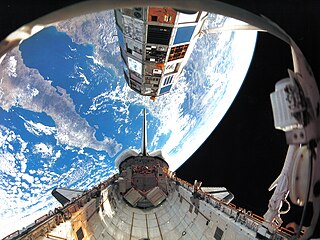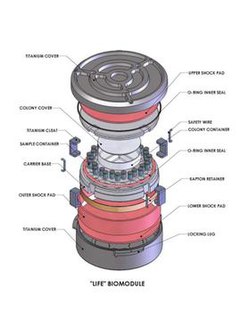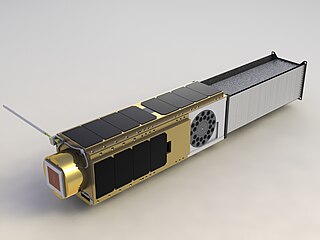
Astrobiology, known as exobiology, is an interdisciplinary scientific field that studies the origins, early evolution, distribution, and future of life in the universe. Astrobiology is the multidisciplinary field that investigates the deterministic conditions and contingent events with which life arises, distributes, and evolves in the universe. It considers the question of whether extraterrestrial life exists, and if it does, how humans can detect it.

Panspermia is the hypothesis that life exists throughout the Universe, distributed by space dust, meteoroids, asteroids, comets, and planetoids, as well as by spacecraft carrying unintended contamination by microorganisms. Panspermia is a fringe theory with little support amongst mainstream scientists. Critics argue that it does not answer the question of the origin of life but merely places it on another celestial body. It is also criticized because it cannot be tested experimentally.

NASA's Long Duration Exposure Facility, or LDEF, was a school bus-sized cylindrical facility designed to provide long-term experimental data on the outer space environment and its effects on space systems, materials, operations and selected spores' survival. It was placed in low Earth orbit by Space ShuttleChallenger in April 1984. The original plan called for the LDEF to be retrieved in March 1985, but after a series of delays it was eventually returned to Earth by Columbia in January 1990.
Foton-M No.2 was an unmanned Foton-M spacecraft which carried a European payload for the European Space Agency (ESA). It was placed into orbit by a Russian Soyuz-U rocket launched at 12:00 UTC on 20 June 2005 from the Baikonur Cosmodrome in Kazakhstan by the Russian Space Agency (RKA). The Foton-M No.2 mission was a replacement for the failed Foton-M No.1 mission, which was lost in a launch failure on 15 October 2002.

Foton is the project name of two series of Russian science satellite and reentry vehicle programs. Although unmanned, the design was adapted from the manned Vostok spacecraft capsule. The primary focus of the Foton project is materials science research, but some missions have also carried experiments for other fields of research including biology. The original Foton series included 12 launches from the Plesetsk Cosmodrome from 1985 to 1999. The second series, under the name Foton-M, incorporates many design improvements over the original Foton, and is still in use. So far, there have been four launch attempts of the Foton-M. The first was in 2002 from the Plesetsk Cosmodrome, which ended in failure due to a problem in the launch vehicle. The last three were from the Baikonur Cosmodrome, in 2005, 2007, and 2014; all were successful. Both the Foton and Foton-M series used Soyuz-U rockets as launch vehicles. Starting with the Foton-7 mission, the European Space Agency has been a partner in the Foton program.

The Young Engineers' Satellite 2 (YES2) is a 36 kg student-built tether satellite that is part of ESA's Foton-M3 microgravity mission. The launch of the Russian Foton-M3 occurred on September 14, 2007 at 13:00 (CEST) by a Soyuz-U launcher. The project was carried out by Delta-Utec SRC and supervised by the ESA Education Office and was nearly entirely designed and build by students and young engineers.

EXPOSE is a multi-user facility mounted outside the International Space Station (ISS) dedicated to astrobiology. EXPOSE was developed by the European Space Agency (ESA) for long-term spaceflights and was designed to allow exposure of chemical and biological samples to outer space while recording data during exposure.

The Living Interplanetary Flight Experiment was an interplanetary mission developed by the Planetary Society. It consisted of sending selected microorganisms on a three-year interplanetary round-trip in a small capsule aboard the Russian Fobos-Grunt spacecraft in 2011, which was a failed sample-return mission to the Martian moon Phobos. The Fobos-Grunt mission failed to leave Earth orbit, and was destroyed.
EXPORT is an exobiology project led by the European Space Agency, that deployed an external module to the International Space Station to study the photo-processing of organic molecules and the survival of some micro-organisms, as well as the effect of solar UV on unshielded organic molecules and micro-organisms while exposed to outer space.

The O/OREOS is an NASA automated CubeSat nanosatellite laboratory approximately the size of a loaf of bread that contains two separate astrobiology experiments on board. Developed by the Small Spacecraft Division at NASA Ames Research Center, the spacecraft was successfully launched as a secondary payload on STP-S26 led by the Space Test Program of the United States Air Force on a Minotaur IV launch vehicle from Kodiak Island, Alaska on 20 November 2010, at 01:25:00 UTC.
Interplanetary contamination refers to biological contamination of a planetary body by a space probe or spacecraft, either deliberate or unintentional.

Exobiology Radiation Assembly (ERA) was an experiment that investigated the biological effects of space radiation. An astrobiology mission developed by the European Space Agency (ESA), it took place aboard the European Retrievable Carrier (EURECA), an unmanned 4.5 tonne satellite with a payload of 15 experiments.
The following page is a list of scientific research that is currently underway or has been previously studied on the International Space Station by the European Space Agency.

The Tanpopo mission is an orbital astrobiology experiment investigating the potential interplanetary transfer of life, organic compounds, and possible terrestrial particles in the low Earth orbit. The purpose is to assess the panspermia hypothesis and the possibility of natural interplanetary transport of microbial life as well as prebiotic organic compounds.
OREOcube is an experiment designed by the European Space Agency (ESA) with the NASA that will investigate the effects of solar and cosmic radiation on selected organic compounds. It will consist in a 12-month orbital study of the effects of the outer space environment on astrobiologically relevant materials in an external exposure facility on the International Space Station (ISS).

BioSentinel is a planned low-cost CubeSat spacecraft on a astrobiology mission that will use budding yeast to detect, measure, and compare the impact of deep space radiation on DNA repair over long time beyond low Earth orbit.
Exposing Microorganisms in the Stratosphere (E-MIST) is a NASA study to determine if a specific microorganism could survive conditions like those on the planet Mars. The study transported Bacillus pumilus bacteria and their spores by helium-filled balloon to the stratosphere of Earth and monitored the ability of the microorganisms to survive in extreme Martian-like conditions such as low pressure, dryness, cold, and ionizing radiation.
Daniela Billi is an Italian astrobiologist working at the University of Rome Tor Vergata. She is known for her work on desert cyanobacteria of the genus Chroococcidiopsis.
Astro microbiology, or exo microbiology, is the study of microorganisms in outer space. It stems from an interdisciplinary approach, which incorporates both microbiology and astrobiology. Astrobiology's efforts are aimed at understanding the origins of life and the search for life other than on Earth. Because microorganisms are the most widespread form of life on Earth, and are capable of colonising almost any environment, scientists usually focus on microbial life in the field of astrobiology. Moreover, small and simple cells usually evolve first on a planet rather than larger, multicellular organisms, and have an increased likelihood of being transported from one planet to another via the panspermia theory.













